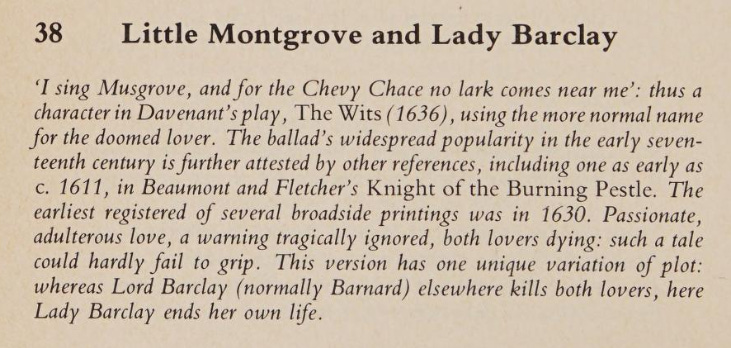There’s a panoply of research and speculation around this one, this is just a taster of the sources for such a popular ballad.
Playlist:
Some links:
“Charles Jessold, Considered as a Murderer” by Wesley Stace - If you like murder mystery novels based on traditional songs, you might find this interesting. I haven’t read it, but it has solidly good reviews.
That’s not the only novel directly inspired by the ballad - here is Deborah Grabien’s “Matty Groves”, a ghost story inspired by the ballad, where a folk band is haunted by the spectres that inhabit the song. I haven’t read this either.
Chaucer and the Traditions of Dawn-Song - This academic article mentions the ballad in the context of “dawn-song” - or poetical verse or balladry involving things happening at the break of day, an interesting topic in itself.
'Both bodily deth and werldly shame': 'Little Musgrave and Lady Barnard' as Source for "A Woman Killed With Kindness" - An article that suggests that the ballad inspired Thomas Heywood’s 1607 play A Woman Killed With Kindness. Make of it what you will!
Matty Groves - A long US version, with a little commentary, from the 1959 edition of Sing Out magazine.
The Knight of the Burning Pestle
Most histories of this ballad include mention of this satirical play, written c. 1607, as the first record of this ballad’s existence. It is still occasionally performed today. You might enjoy this two and a half hour audio version. It’s fairly heavy going, though, you have been warned:
Here’s the relevant passage, if you don’t fancy wading through the whole thing.
The American tradition
This article from the Appalachian Journal in 1975 about legendary US guitarist and singer Doc Watson is interesting as an example of the American tradition in action. Here’s an excerpt that mentions his version of Matty Groves:
Here’s his song:
Little Musgrave → Matty Groves → Shady Grove
Of course the ballad most associated with Roud 52 is the apparently unrelated Appalachian love song Shady Grove (Roud 4456) - Fairport Convention used the tune of Shady Grove for their seminal version of Matty Groves in on their 1969 Liege and Lief album. The American song, a fairly straightforward number with no murders or other drama, probably originates from an early 20th Century Kentuckian source. I’ve seen some suggestions that Shady Grove came into existence as a sanitised version of Matty Groves, but there’s no evidence of that in the text that I can see. However, I haven’t done an exhaustive search of the Shady Grove sources (you’ll have to wait for Sing Yonder #446 for that), so I’l be happy to be proved wrong.
Visual representations
Here’s a beautiful illustration of the titular lovers from Helen Temperley.
I also love this from Ian Serraillier’s 1975 ballad anthology, “I’ll Tell You a Tale” - look at Matty’s pointy boots!
(The illustrator is Hugh Marshall, responsible for a load of book covers in the 1960s-1970s. Well worth googling (I could easily fall down a rabbit hole of finding them all, I’ll leave that to someone else though.) He has a really striking and for me, a child of the 70s, a highly evocative style.)
Finally this one, from the Bodleian ballad collection:
A woman and a man hold hands, then two men have a fight. A tale as old as time. (This is the actual broadside that has the tantalising, but possibly misleading note on the back mentioned in the book.)
The Hollywood Connection
The following account from Roy Palmer’s “Everyman’s Book of British Ballads” led me on an interesting side-quest.
That first quote sent me, inevitably, to the Wikipedia page of Hollywood comic actor Chevy Chase, where I found this:
Chase was named for his adoptive grandfather, Cornelius, while the nickname "Chevy" was bestowed by his grandmother from the medieval English ballad "The Ballad of Chevy Chase". As a descendant of the Scottish Clan Douglas, she thought the name appropriate.[12]
“The Ballad of Chevy Chace” is Roud 223. I always enjoy it when the normally fundamentally opposed worlds of Hollywood filmmaking and traditional song cross over.








